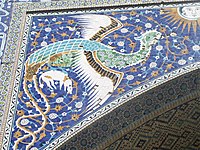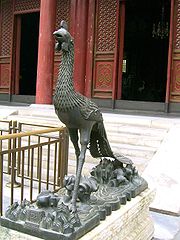In Persian mythology, Simurgh, (Persian: سيمرغ, Middle Persian: senmurv) was a winged, bird-like creature that was very large and extremely ancient. The Simurgh appears in many Iranian literary classics such as Farid ud-Din Attar's Conference of the Birds as instructor and birds leader, and in Ferdowsi's epic Shahnameh (The Book of Kings); Simurgh raised up and cherished Zaal or Zal, father of Rostam.
The phoenix the central figure in Lebanese ancient and modern cultures, as Lebanese are descendants of the Phoenicians and often claim themselves sons of the Phoenix.Lebanon, and Beirut particularly, is often depicted symbolically as a phoenix bird having been destroyed and rebuilt 7 times during its long history.
In China, Fenghuang ("鳳凰") is a mythical bird superficially similar to the phoenix. It is the second most-respected legendary creature (second to the dragon), largely used to represent the empress and females. The phoenix is the leader of birds.
In Japan, the phoenix is called hō-ō(kanji:"鳳凰") or fushichō (不死鳥), literally "Immortal Bird".
In Russian folklore, the phoenix appears as the Zhar-Ptitsa (Жар-Птица), or firebird, subject of the famous 1910 ballet score by Igor Stravinsky. The phoenix was featured in the flags of Alexander Ypsilantis and of many other captains during the Greek Revolution, symbolizing Greece's rebirth, and was chosen by John Capodistria (1828-1832). In addition, the first modern Greek currency bore the name of phoenix. Despite being replaced by a royal Coat of Arms, it remained a popular symbol, and was used again in the 1930s by the Second Hellenic Republic. However, its use by the military junta of 1967-1974 made it extremely unpopular, and it has almost disappeared from use after 1974, with the notable exception of the Greek Order of the Phoenix). It was introduced by Johann Bayer in 1603.
wikipedia


Tidak ada komentar:
Posting Komentar